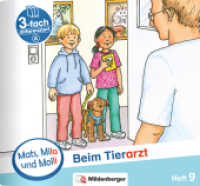Full Description
Not for ESOL Teachers: What every classroom teacher needs to know about the linguistically, culturally, and ethnically diverse student provides the basics and background information needed to teach English learners in the classroom. This publication continues to be a labor of love for the student who is learning through a foreign language. It has tremendous affection, respect, and compassion for the mainstream teacher who is not a trained teacher of English to speakers of other languages (TESOL).
New to the 3rd edition:
A more uniform chapter format - updated references, key points, final points, more voices from stakeholders, and online resources for further learning are available in each.
Several new chapters:
Teaching Science to English Learners
Teaching Social Studies to English Learners
Teaching English Learners Literacy through the Arts
Vocabulary Development
Working with Parents of ESOL Students
Significant revisions to all chapters to include the most critical information on changes that have occurred in the field.
Contents
Preface
Part 1 - Classrooms of Today
Chapter 1 - Who are our Students
Chapter 2 - Culture Diversity in the Mainstream Classroom - Who Am I
Chapter 3 - Cross Cultural Understandings in Academic Settings
Chapter 4 - Diverse Learning Styles
Part 2 - The Perplexity and Complexity of Learning Another Language
Chapter 5 - What Teachers Need to Know About First and Second Language Acquisition
Chapter 6 - The School Experience for the New English Learner
Part 3 - Learning English Through Integration of Academic Content
Chapter 7 - Why Integrate Language and Content
Chapter 8 - Differentiated Instruction for English Learners
Chapter 9 - Literacy, Technology, and the English Language Learner
Chapter 10 - Teaching Math to English Learners - Myths and Methods
Chapter 11 - Teaching Science to English Learners
Chapter 12 - Teaching Social Studies to English Learners
Chapter 13 - Teaching English Learns Literacy through the Arts
Chapter 14 - Vocabulary Development in a Literacy Curriculum (From elementary to older Els): An Action Plan
Part 4 - Assessment and the English Learner
Chapter 15 - Traditional Assessment: Why it is Inappropriate
Part 5 - English Language Learners and the Wider CommUnity
Chapter 16 - Working with Parents of ESOL Students
Chapter 17 - Beyond the Classroom Walls - Suggestions for Noninstructional Staff
Part 6 - Sampler of Cultural Groups - The Teacher as Cultural Observer
Chapter 18 - Hispanics, Latino/as and Spanish Speakers
Chapter 19 - Jamaicans in the American School System: A New Understanding of Language and Culture
Chapter 20 - Muslims, Followers of Islam, and Speakers of Arabic
Chapter 21 - Chinese, Japanese, South Korean, and Indian
Chapter 22 - Haitians
Chapter 23 - Native Americans
Appendix A - ESOL Methods and Strategies
Appendix B - Language Level Classifications and Descriptions
Appendix C - Sample of Modified Lesson Plan - Science
Appendix D - Class Assignment - Textbook Analysis Form
Appendix E - Project Rubric for Modification of Textbook
Appendix F - SIOP Lesson Plan Guide
Appendix G: Resources: Journals and Websites
Glossary
References
Index







